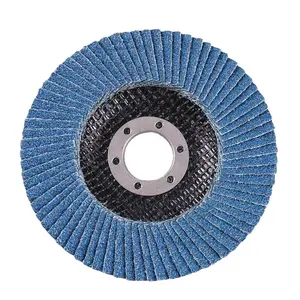Beliebt in Ihrer Branche






T27 Zirkon oxid Aluminium oxid Schleif klappens cheibe für Edelstahl
0,214 € - 0,2791 €
Mindestbestellmenge: 500 Stück






Klappscheiben 20-teiliges Schleifwerk 4-1/2 × 7/8 Zoll 40/60/80/120 Kieselklappscheibe T29
10,93 € - 12,86 €
Mindestbestellmenge: 1 Satz







5-Zoll 125 mm Kalzinierte Aluminiaplatte Packungsdiskie Schleifwerkzeuge für Stahl und Edelstahl Schleifen
0,2419 € - 0,2884 €
Mindestbestellmenge: 300 Stück







100mm 115mm Poliers ch eiben 125mm Kunststoff-Glasfaser-Schleif scheiben Klappens cheibe zum Metalls chleifen
0,1396 € - 0,2605 €
Mindestbestellmenge: 100 Stück







Zirkonia 4-zoll fiberglas-unterlage 100mm klappenscheibe zum Metallschleifen
0,1489 € - 0,1675 €
Mindestbestellmenge: 300 Stück







LIYING Aluminium-Oxid-Harz-Faserscheibe Schleifscheibe für Metall-Edelstahl-Polier-Schleifwerk
0,1024 € - 0,1396 €
Mindestbestellmenge: 100 Stück







4,5 Zoll 115mm 40 600 Körnung Galvani sierte trockene nasse flexible Schleif glass chleif diamant klappens cheibe für Marmor und Granit
12,93 € - 17,58 €
Mindestbestellmenge: 50 Stück






Schlussverkauf Aluminium-Oxid-Flappen scheibe 115 mm 150 mm Größe Körnung 40 bis 600 Körnung Flappenscheibe Preis
0,121 € - 0,1396 €
Mindestbestellmenge: 1000 Stück






Flex 180mm Preis 600 Red Elastic A240 Platte Günstige Keramik verdickte Klappens cheibe
0,121 € - 0,1396 €
Mindestbestellmenge: 100 Stück






Schlussverkauf Schnittepapier Schotter 600 Aluminium-Oxid zum Polieren von Metallklappscheibe
0,2791 € - 0,3721 €
Mindestbestellmenge: 10 Stück






Aluminiumoxid-Schleif klappens ch eiben mit Körnung 600 zum Polieren von Metallen und Edelstahl
0,1582 € - 0,1861 €
Mindestbestellmenge: 500 Stück
Ähnliche Suchanfrage:
klappen scheibe 4klappen scheibe p60klappen scheibe 3mflap disc spezifikationenklappen scheibe 2flap disc deutschlandklappen scheiben typenklappen scheibe für holzklappen scheibe für metallflap disc importeurklappen scheibe 125klappen scheibe sflap-scheiben harzgebogene klappen scheibeflap disc beste qualität






Neue 600 Schleifenstiel-Schwarzpoliermaschine Vliesstoff-Klappe-Scheiben zum Polieren und Mahlen
2,57 € - 3,83 €
Mindestbestellmenge: 10 Stück



A/O-Klappens cheibe, Mop-Scheibe Kingdom Abrasive, Aluminiumoxid-Klappens cheibe
0,5581 € - 0,7441 €
Mindestbestellmenge: 3000 Stück






Hybride flexible Klappens cheibe Diamant klappens cheibe 4 1/2 in 115 mm Getreide 40 60 120 200-Körnung Schleif diamant klappen rad für Fliesen keramik
9,31 € - 12,93 €
Mindestbestellmenge: 5 Stück






Heißer Verkauf 4/4,5/5/6 Zoll Französisch Latex Papier gelb Schleif Hookit Schleif scheibe Sandpapier Scheibe
0,0549 € - 0,0763 €
Mindestbestellmenge: 2000 Stück






20 Packs Gemischt Alumina/Zirkonia 40 80 Grit Flap Disc 115x22,2mm Winkel mühlen Klappe Disk
Sofort lieferbar
0,121 € - 0,6046 €
Mindestbestellmenge: 10 Stück
Versand pro Stück: 3,12 €





Disc Flap Kunden spezifische hochwertige scharfe 80 mt/s Schleif scheibe zum Polieren von Metall mit Glasfaser rücken Factory Direct Sale
0,1396 € - 0,1768 €
Mindestbestellmenge: 1000 Stück






Schleif klappens cheibe des Schleif herstellers für Auto politur
0,1954 € - 2,98 €
Mindestbestellmenge: 1 Stück






4 zoll Vertikale Klappe Disc 40 Grit Aluminium Oxid Schleifen Scheiben
0,0745 € - 0,1303 €
Mindestbestellmenge: 10000 Stück






China-lieferanten neue produkte diamantschleifmittel fächerschleifscheibe für glas stein keramik schleif-und polierwerkzeuge
17,68 € - 45,58 €
Mindestbestellmenge: 2 Stück






Hohe qualität zirkonium schleif klappe disc, klappe disk T27/T29 hersteller
0,4651 € - 0,5581 €
Mindestbestellmenge: 100 Stück












4 Zoll Blumenklappenscheibe 100 mm Kalzinierter Aluminium-Oxid-Radialklappenscheibe flexible Klappenscheibe zum Mahlen und Polieren
0,1396 € - 0,2419 €
Mindestbestellmenge: 5000 Stück











Abraser Hersteller 115mm Schleif scheibe Poliers cheibe Zirkon oxid klappens cheibe für Edelstahl
0,121 € - 0,1675 €
Mindestbestellmenge: 10 Stück






4,5 "/115mm * 22mm Lamellenschleifscheibe Schmirgelpapier überlappt Schleifscheiben für polieren 72 klappen
0,214 € - 1,06 €
Mindestbestellmenge: 2000 Stück






4 1/2 ''* 7/8'' Körnung 60 Schleif klappens cheibe Glasfaser klappens cheibe
Sofort lieferbar
156,26 € - 195,33 €
Mindestbestellmenge: 1 Karton
Versand pro Stück: 108,59 €






150x6x18mm Nylon Unitized Poliers cheibe Super dünne Schleif scheibe zum Schweißen von Punkts chlitz schlitzen aus Edelstahl
Sofort lieferbar
0,2791 € - 0,6511 €
Mindestbestellmenge: 1000 Stück
Versand pro Stück: 0,1489 €










Zirkonoxidoxid-Schleif scheibe Klappens cheibe T29 Klappens cheibe 4,5 Zoll Klappens cheibe 40/60/80/120 Körnung
0,3256 €
Mindestbestellmenge: 10000 Stück






Zirkonoxid-Klappens chleif scheibe Zirkonium-Schleif klappens cheibe zum Metalls chleifen Polieren
0,1582 € - 0,1768 €
Mindestbestellmenge: 10 Stück






Schmuck polier werkzeuge 8 Zoll galvani sierte Diamantklappen-Überlappung scheibe
37,21 € - 41,86 €
Mindestbestellmenge: 5 Stück






T27 T29 Körnung 40 Körnung 60 Körnung 80 120 240 320 400 Aluminium oxid klappens cheibe 125mm
0,1768 € - 0,2698 €
Mindestbestellmenge: 5000 Stück









Abrasive Schleifpapier Chuck Klappe Rad Klappe Disc für Edelstahl
1,68 € - 3,26 €
Mindestbestellmenge: 100 Stück






XMGT Vlies Poliers cheibe Winkels chl eifer 100*19mm Schleif klappe Scheiben schleif scheiben für Holz Metall Edelstahl
2,22 € - 3,15 €
Mindestbestellmenge: 100 Stück


Abrasive klappe disc für metall, doppel flap blätter polieren klappe rad für edelstahl 125x 22.2mm,80 MT/S
0,214 € - 2,80 €
Mindestbestellmenge: 1 Stück






4,5 Zoll 115mm M14 Diamant-Hybrid klappens cheibe mit Gewinde zum Polieren von Dekton-Keramik-Porzellan fliesen
Sofort lieferbar
17,21 € - 18,14 €
Mindestbestellmenge: 10 Stück
Versand pro Stück: 2,55 €
Top-Kategorien
Über klappen scheibe 600
Entdecken Sie das Aufregende. klappen scheibe 600 Bereich auf Alibaba.com zu günstigen Preisen. Zu den einzigartigen Produkten gehören traditionelle und innovative Produkte aus verschiedenen Kontinenten. klappen scheibe 600 haben unterschiedliche Geschmäcker und Zutaten, um mehrere Paletten anzusprechen.
klappen scheibe 600 sind hochwertige essbare Produkte, die nach Standardverfahren hergestellt werden. Die Esswaren werden mit hochwertigen Rohstoffen verarbeitet. Sie sind lange haltbar und können daher länger verwendet werden. Die Produkte sind frei von Zusatzstoffen und schädlichen Konservierungsstoffen. Auf der Website sind auch nahrhafte Optionen mit Samen und Kräutern erhältlich. Die Snacks sind salzig, süß und würzig im Geschmack. Snacks sind auch in einer praktischen Verpackung erhältlich, damit sie auch unterwegs getragen werden können. Die Produkte sind das ganze Jahr über absolut sicher. Sie sind auch für Weight-Watcher geeignet, die mit fettarmen und kohlenhydratarmen Bestandteilen gekocht werden.
Finden Sie eine fantastische. klappen scheibe 600 Bereich auf Alibaba.com, der Ihrer Rechnung entspricht. Wenn Sie nach einem Großeinkauf suchen, haben Sie auf die richtige Website zugegriffen. Die aufgeführten Hersteller und Lieferanten bieten außergewöhnliche Produkte und Dienstleistungen. Fragen Sie jetzt an und Sie werden mit diesem Kauf absolut zufrieden sein.
klappen scheibe 600 sind hochwertige essbare Produkte, die nach Standardverfahren hergestellt werden. Die Esswaren werden mit hochwertigen Rohstoffen verarbeitet. Sie sind lange haltbar und können daher länger verwendet werden. Die Produkte sind frei von Zusatzstoffen und schädlichen Konservierungsstoffen. Auf der Website sind auch nahrhafte Optionen mit Samen und Kräutern erhältlich. Die Snacks sind salzig, süß und würzig im Geschmack. Snacks sind auch in einer praktischen Verpackung erhältlich, damit sie auch unterwegs getragen werden können. Die Produkte sind das ganze Jahr über absolut sicher. Sie sind auch für Weight-Watcher geeignet, die mit fettarmen und kohlenhydratarmen Bestandteilen gekocht werden.
Finden Sie eine fantastische. klappen scheibe 600 Bereich auf Alibaba.com, der Ihrer Rechnung entspricht. Wenn Sie nach einem Großeinkauf suchen, haben Sie auf die richtige Website zugegriffen. Die aufgeführten Hersteller und Lieferanten bieten außergewöhnliche Produkte und Dienstleistungen. Fragen Sie jetzt an und Sie werden mit diesem Kauf absolut zufrieden sein.


































